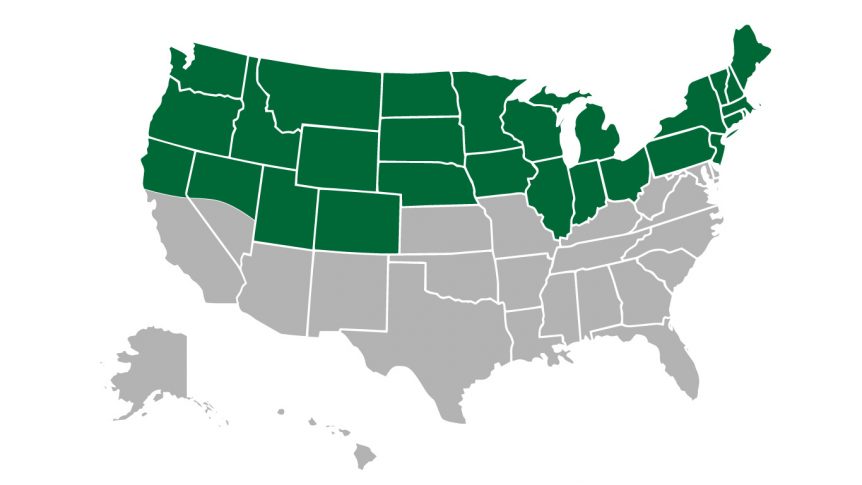Ah spring, when the sun finally begins to pry loose the icy grip of winter and those cooped up for months break free to fill their lungs with fresh air. Green thumbs that have twiddled anxiously in anticipation of a new growing season can, at long last, be turned loose to the task. The following are some to-do list items to ease lawns from their slumber and prepare them for the warm days ahead.
1. Repair and Prepare
Peter Landschoot, Penn State turfgrass specialist, says to first be sure the mower cut height is set to the correct height when it comes time to give grass its first trim of the growing season. He warns not to get too aggressive with mowing, instead setting the cut height at 2 to 3.5 inches tall. “The shorter you cut your grass the more frequently you have to mow,” Landschoot says. The general rule is take no more than one third of the foliage. Mowing shorter means it takes less time to regrow that foliage, upping frequency to maintain the desired height. “If you mow too short you also tend to have more weed problems. The canopy isn’t as dense, and more light reaches the soil to help germinate weed seeds.”
Early spring is also a great time to take a soil sample. The tests usually run in the neighborhood of $10 and results are delivered in 2 to 3 weeks. A soil test will provide soil pH and recommendations for phosphorus, potassium and sometimes micronutrients. “It’s not uncommon to find you don’t actually need to apply additional fertilizer [phosphorus or potassium], which can save you money,” Landschoot says.
If pH is too low, lime can be used to bring soils closer to neutral. “Strongly acidic soils bind up essential nutrients like phosphorus. Even if you put fertilizer down, the plant can’t use it as efficiently,” Landschoot says. “A soil pH below 5.5 can result in poor color and thinning turf that can lead to more weed problems.”
2. Weed and Feed
Crabgrass control is next on the list. The best way to control crabgrass is with a preemergence herbicide. “You have to apply the herbicide so that when the crabgrass germinates in the soil the herbicide is there to kill it before it emerges,” Landschoot says. Timing is critical. If the window is missed little can be done about crabgrass until spring rolls around again. Those planning to do any seeding in spring should skip crabgrass control as most preemergence herbicides will have the same effect on turfgrass seed.
A general rule, Landschoot says, is to apply when forsythia is in full bloom sometime in April. But that indicator doesn’t work perfectly. For best results, he suggests checking state cooperative extension web sites that monitor conditions and offer geographically relevant application timing.
Many crabgrass preemergence herbicides are impregnated on fertilizer, making for an easy weed and feed option. “Applied in early April, the fertilizer should take your lawn through late May or longer,” Landschoot says. Those aiming for a showpiece lawn, or who are maybe nurturing a younger lawn, may consider another fertilizer application at that point. If a lower maintenance lawn is the desired result, just the one fertilizer application will do until late summer or fall, he says.
3. Broadleaf Weed Control
As spring wears on and temperatures continue to rise, broadleaf weeds will soon start making an appearance. Patience in this department will be rewarded. “Rather than spraying right when the weeds come up, I like to wait until late May to apply a broadleaf herbicide because I know more weeds are coming,” Landschoot says. Most broadleaf herbicides are liquid and require leaf contact to work.
Though Landschoot recommends a liquid herbicide for best results, there are granular broadleaf herbicides available. If using a granular formulation, he says to be sure and apply in early morning when there is dew on the leaves to help herbicide particles stick to the target plants.
4. Seeding
The excitement of getting back in the yard may mean wanting to do too much. When possible, Landschoot recommends saving major work, such as aeration, thatching, grading, laying sod and seeding, for late summer or fall. “Soils tend to be wet and cold in the spring making them difficult to work in and slow to germinate seeds,” he explains. “In fall, soils are warm and dry, which is better for plants and for work like tilling or grading.”
If some patch seeding is necessary to deal with dead or damaged spots, some preparation is needed. As previously mentioned, make sure to forgo the preemergence crabgrass herbicide. The site will also need to be prepared. “Don’t throw grass over dead grass or thatch,” Landschoot says. “Take the time to clear the dead grass and get down to bare dirt before spreading seed.” He recommends using perennial ryegrass for spring seeding as it will germinate in colder temperatures than other cool-season grasses and germinates in about 7 to 10 days as compared to more than 20 days for a species like Kentucky bluegrass.
Helpful links:

